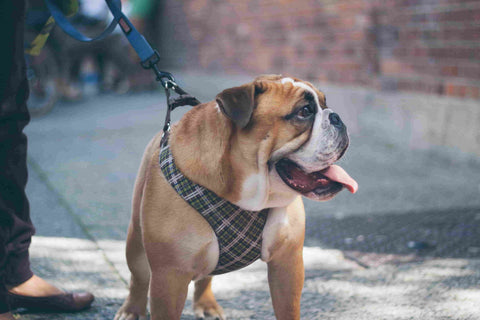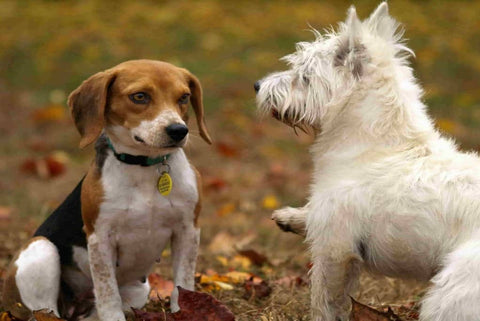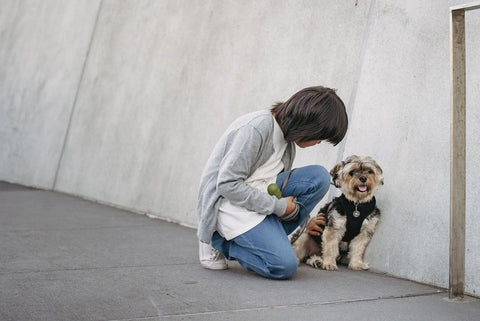How to Leash Train a Dog or Puppy
Getting your dog used to being on a leash should be a top priority. After all, leash training is an essential skill that makes walking, training, and other activities safer for both canine and parent. It also helps ensure the safety and comfort of other pedestrians and dogs. With proper leash training, your furry pal will stay with you for the entire walk and not be tempted to chase after birds or squirrels. Today, we’ll discuss the most effective techniques you can use when leash training a puppy or adult dog.
Best Leash Training Techniques for Dogs
Before you can start teaching your dog how to properly walk with a leash, you need to get her used to the accessory itself. Of course, this happens before you even put the leash on at all.
First, you’ll want to double-check that you have the right size collar or harness (note: a harness is a much safer and more comfortable option when leash training). Then, once you have your harness and leash ready, give your furry friend time to get acquainted with them inside the house. Let her smell them while they are lying on the ground, then pick them up and let her interact with them. Once she sees they aren’t a threat, she’ll be more comfortable with having them put on. Now that you’ve practiced indoors, it’s time to move training outside.
Pro tip: After a short duration of wearing the harness and leash, give your furry friend some extra playtime and treats. Associating the leash and harness with fun and snacks is a great way to get your pup used to them.
Train Your Dog to Walk on a Loose Leash
Loose leash training is a technique that encourages your dog to leave slack on the leash. That means no pulling or tugging, so you can have a stress-free walk together. Ideally, your four-legged friend will be walking alongside you with close to zero tension in the leash. Here’s what you’ll need and how to train for loose leash walking.
- Your leash, preferably a retractable leash that has a lock-and-release button. This type of leash is more functional and will make loose leash training a puppy or dog much easier.
- High-value treats. Go for one of your dog’s favorites for extra motivation!
- An appropriately sized dog harness or collar. A harness will be a better choice for training than a plain collar. If your dog tends to pull, opt for a front- or dual-clip harness.
Now that you have your tools ready, you can begin following these simple steps for loose leash walking. Of course, you can always begin training your dog inside the house to limit distractions. Once she’s shown she can handle a few simple commands, you can take her outside for advanced practice.
- Call our dog’s name and give her a treat when she comes to your side.
- Take a couple of steps while you call her name and give her a treat.
- Once she’s shown that she will move with you, put on the collar or harness and distract her with light playtime.
- Take a few steps while encouraging your dog to join you. Then, as she responds positively, take more steps at a time. Keep giving her treats if she gets distracted or stops walking with you.
Teach Your Dog to Heel
“Heeling” is a dog-walking technique that teaches your dog to stay by your side and match your pace. It limits movement and reduces the tendency to wander off and explore and is a great walking practice in busy parks and streets and indoor places like shops and airports. Here’s how to teach your dog to heel.
First, you’ll need to gather your tools.
- A retractable leash with a lock feature for better leash length regulation.
- A suitably sized dog harness or collar. A harness is a better choice for leash training since it optimizes control. Even better, a front clip harness will reduce pulling in energetic dogs.
- Your dog’s favorite treat. A high-value treat will work better than a treat your dog doesn’t care for as much.
With your tools at the ready, you can start teaching your dog to heel. Remember, you can always begin training indoors to limit distractions. Then, once your pup has a handle on the commands and expectations, you can move training outside. Here’s a quick step-by-step guide:
- Call your dog to either your right or left side and reward her with a treat. Which side you call her to simply depends on your preference.
- Keep the treats flowing to encourage action and focus.
- Take one step forward and call her to come closer to the side you have chosen. When she comes, reward her with a treat.
- Take a step to the side and call her to your side; reward her when she arrives. Keep moving around and reward her when she arrives at the correct side. Add the command “heel” to the movement.
- Put on the harness and attach the retractable leash and repeat step 4. Start and stop randomly and reward her when she responds correctly. Remember, there should never be any tension in the leash if the dog is heeling properly.
- When the heeling session is over, give your dog a release command such as “okay” or “all done.”
- Take the training outside to try out her reaction to distractions. Continue leveling up her training by adding more distractions, such as going to a dog park or a longer walk.
Effective Tips for Training a Dog to Walk on a Leash
Training a dog to walk on a leash safely and comfortably for all involved is a challenging task; there will probably be a few hurdles that you’ll have to come. But don’t worry – you’re not alone. Pet parents like you face a few common issues when learning how to leash train a puppy. Below are a few of these issues and what you can do to resolve them. The following tips are great for training puppies as well as adult dogs that already have some training.
- If your dog pulls on the leash, stop walking. Instead, call your dog to you and wait until she arrives. Then, take 2-3 steps forward. If she doesn’t pull, reward her with a treat. If she still pulls, try out specific no-pull harnesses that discourage the dog’s pulling.
- If your dog lunges after other dogs, birds, squirrels, or anything else, distract your dog with treats as you increase the distance between her and the object of her attention. If you have taught her the vocal command “heel” or “stay,” use these.
- If your dog weaves back and forth or runs circles around you, lure her to the right or left side (your choice) with the retractable leash and a treat. Then take a few steps forward and reward her when she stays on the correct side. Shorten the leash length, so you have better control over her movements. Always reward her with a favorite treat when she obeys the command.
- If your dog keeps stopping to sniff on walks, you should focus on loose leash training. New commands like “leave it” or “watch/with me” can help keep her focused while walking. However, be aware that dogs explore their environment through smell, so be understanding of their needs.
- To enhance the dog’s learning, make sure to use your chosen commands regularly and consistently while practicing.
Why is Leash Training Important?
The importance of leash training can’t be overstated. It’s one of the most useful skills your dog will learn. To begin with, it enhances safety for you and your dog by keeping your pet’s movements under control and making them more predictable. Plus, with leash training, your dog will learn to stop pulling when you take walks together, which is much better for your dog’s neck and shoulders. Plus, it gives a more comfortable walking experience for her human companions since a dog that pulls can cause injury to your own body, like the rotator cuffs. Finally, a dog that isn’t properly leash trained will find being on a leash frustrating and annoying, leading to leash reactivity and unexpected behavior.
Get Your Best Dog Leashes and Harnesses from Pet&Cuddle!
It’s never too late to start leash training, and every puppy and dog can benefit from it. This essential skill will help you and your four-legged friend enjoy walks together in a safe and controlled way. To get the most out of your leash training sessions, you’ll want the right harness and other accessories.
At Pet&Cuddle, we know just how crucial the right training tools are, so we put extra care and attention into designing our collars, harnesses, and leashes. All of our premium dog products are specifically created for a variety of activities, from sports to walking to running to high-intensity agility training. And now that you know just how to leash train a dog or puppy, it’s time to find the perfect harness and leash in our shop today!
Because our canine experts love dogs just as much as you do, they’ve created the ultimate harnesses for every dog, even the most energetic ones that love to run and pull. Our focus is on safety, comfort, and style, so you never have to compromise on getting the most out of your training accessories. And because our harnesses have features and materials usually only found on much more expensive harnesses, you won’t feel like you’re breaking the bank. Instead, we believe every dog – and their human – should have access to the perfect harness for running, walking, hiking, training, and more.
Want to know more about the best dog training equipment for your dog? Check out our latest dog accessory collection!
Questions about Leash Training for Dogs
If you still have a few questions about how to leash train a dog or puppy, we can help. Here are some of the most commonly asked questions from pet parents like you.
How long does it take to leash train a dog?
When it comes to training a dog, consistency is key, and a little bit goes a long way. Typically, you can work with your dog for around five minutes two or three times a day to see results. Of course, the more frequent the training sessions, the quicker you’ll see quality results.
Why is loose leash walking important?
The loose leash walking technique allows your dog to comfortably discover the world and explore the environment through sniffing while still maintaining the safety and comfort of you and your pet. Any type of training will limit unexpected and unpredictable behavior and reduce the possibility of injury to either of you.
How do I get my dog to stop pulling on the leash?
Experienced dog trainers recommend thorough leash training to discourage pulling. If you’re not sure how to leash train a dog that pulls, simply follow the step-by-step guides we listed above while using a specific no-pull dog harness designed for discouraging your dog’s pulling.
Why does my dog keep stopping and sniffing on walks?
Dogs have an incredible sense of smell – up to 100,000 times stronger than humans’! It’s the main way they explore the world. Plus, deep breathing is a great way to relax and calm down, so some canines use it as a way of self-soothing.




